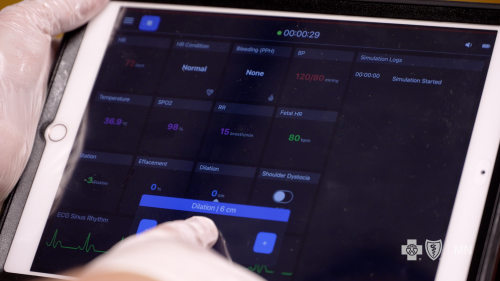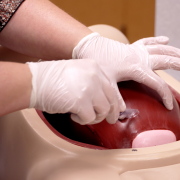
First-ever simulation technology improves access to rural obstetrics
According to research from the University of Minnesota, expectant mothers living in rural areas are nine percent more likely to die or experience life-threatening complications during childbirth, compared to those living in an urban area.

This unfortunate reality is due in part to the fact that more than half of rural counties across the country have no hospitals that provide routine labor and delivery services, which means patients must travel much further to receive this necessary care.
“Long-distance travel is commonly cited as one of the biggest barriers to health care for our members,” said Karen Amezcua, senior director of provider partnerships at Blue Cross. “As we continuously work to ensure we are providing access to the full continuum of care across our network, it’s crucial that rural area hospitals maintain a high level of skill and confidence in obstetrics.”
Access to labor and delivery services is critical
Because labor and delivery skills require constant repetition, many rural hospitals with only a small number of births each year must look for other opportunities to keep skills and knowledge sharp and up-to-date. Too often, this challenge for rural hospitals leads to obstetric department closures and longer travel times for patients.
Community Memorial Hospital (CMH) in Cloquet, MN is known as a critical access hospital, which is an official designation for hospitals in rural areas with patients who would otherwise need to travel a long distance for emergency care. Located about 25 miles southwest of Duluth, CMH serves a large geographical area, including the Fond du Lac Reservation, which has its tribal headquarters in Cloquet.
“For a critical access hospital like ours, it’s important that our physicians, nurses and support staff are trained appropriately for all types of labor and delivery care – from vaginal deliveries and c-sections to emergency hysterectomies,” said Rick Breuer, the hospital’s CEO.
After exhausting all options to increase training opportunities – including the possibility of sending staff on mission trips to help deliver babies – CMH decided that solving this challenge was something they needed to do themselves. The Operative Experience simulation product was highly recommended by obstetric surgeons – it just came down to funding.
“We were thrilled when Blue Cross informed us they would cover the full initial costs of the equipment,” said Breuer. “This has been a game-changing moment for us, as it makes this conceptual possibility into a reality.”
Expanding training opportunities

The simulator features life-identical soft tissue and skin and accurate internal anatomy.
In addition to providing training for its own health care professionals, CMH will make the obstetrics simulator available to other rural providers across the state who are facing similar challenges.
“Our vision for the use of this equipment is for us to establish an obstetrics simulation lab for rural Minnesota hospitals and their care teams,” said Breuer. “We intend to provide a low cost means for physicians, other providers, and nurses from other rural hospitals to gain periodic immersion experiences in various maternal health scenarios.”
CMH is also working with the University of Minnesota Duluth medical school and multiple area nursing programs on opportunities to incorporate the lab into their curriculum. In the future, Breuer also sees this innovative technology as a way to train other health care professionals who may encounter labor and delivery situations, including Emergency Department staff.
Through community investments and advocating for more equitable policies and systems, Blue Cross has long been committed to improving health equity across the entire state. Health disparities are not only present in urban populations and rural access to obstetrics is one glaring example of that, which CMH has set out to overcome.
“Blue Cross anticipates that our investment in this state-of-the-art technology will improve the sustainability of high-quality care for expectant mothers by eliminating barriers that lead to worse health outcomes,” added Amezcua.
